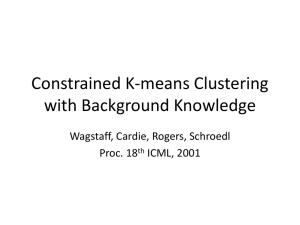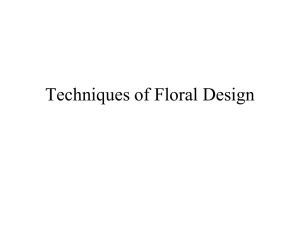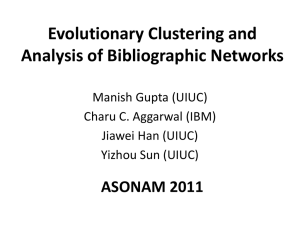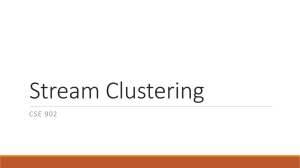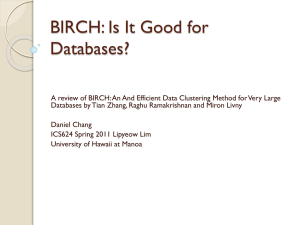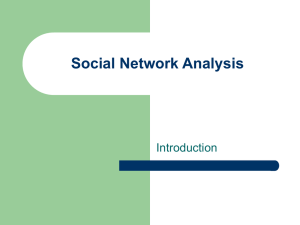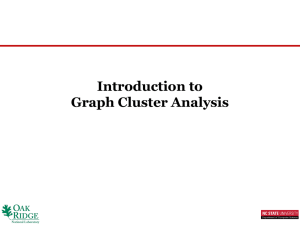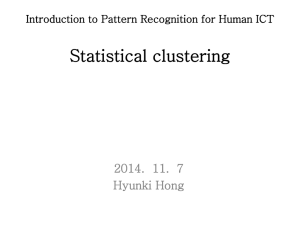ppt - CUNY
advertisement
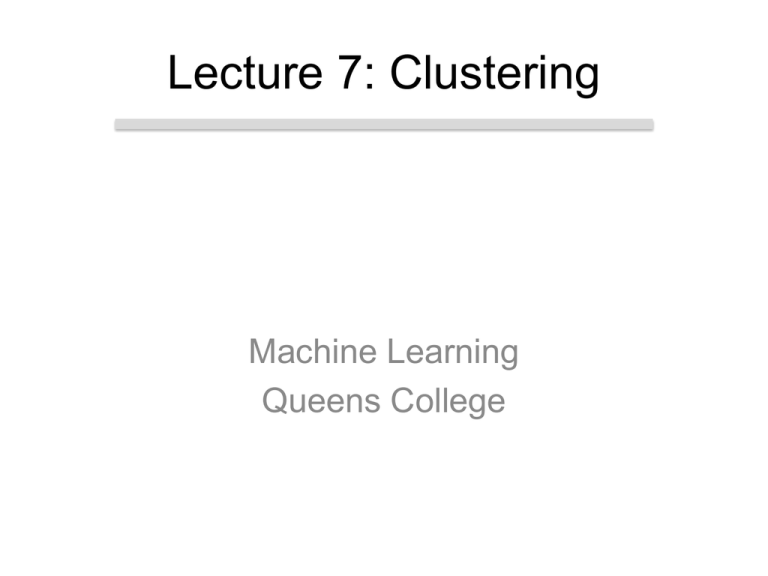
Lecture 7: Clustering Machine Learning Queens College Clustering • Unsupervised technique. • Task is to identify groups of similar entities in the available data. – And sometimes remember how these groups are defined for later use. 1 People are outstanding at this 2 People are outstanding at this 3 People are outstanding at this 4 Dimensions of analysis 5 Dimensions of analysis 6 Dimensions of analysis 7 Dimensions of analysis 8 How would you do this computationally or algorithmically? 9 Machine Learning Approaches • Possible Objective functions to optimize – Maximum Likelihood/Maximum A Posteriori – Empirical Risk Minimization – Loss function Minimization What makes a good cluster? 10 Cluster Evaluation • Intrinsic Evaluation – Measure the compactness of the clusters. – or similarity of data points that are assigned to the same cluster • Extrinsic Evaluation – Compare the results to some gold standard or labeled data. – Not covered today. 11 Intrinsic Evaluation cluster variability • Intercluster Variability (IV) – How different are the data points within the same cluster? • Extracluster Variability (EV) – How different are the data points in distinct clusters? • Goal: Minimize IV while maximizing EV 12 Degenerate Clustering Solutions 13 Degenerate Clustering Solutions 14 Two approaches to clustering • Hierarchical – Either merge or split clusters. • Partitional – Divide the space into a fixed number of regions and position their boundaries appropriately 15 Hierarchical Clustering 16 Hierarchical Clustering 17 Hierarchical Clustering 18 Hierarchical Clustering 19 Hierarchical Clustering 20 Hierarchical Clustering 21 Hierarchical Clustering 22 Hierarchical Clustering 23 Hierarchical Clustering 24 Hierarchical Clustering 25 Hierarchical Clustering 26 Hierarchical Clustering 27 Agglomerative Clustering 28 Agglomerative Clustering 29 Agglomerative Clustering 30 Agglomerative Clustering 31 Agglomerative Clustering 32 Agglomerative Clustering 33 Agglomerative Clustering 34 Agglomerative Clustering 35 Agglomerative Clustering 36 Agglomerative Clustering 37 Dendrogram 38 K-Means • K-Means clustering is a partitional clustering algorithm. – Identify different partitions of the space for a fixed number of clusters – Input: a value for K – the number of clusters – Output: K cluster centroids. 39 K-Means 40 K-Means Algorithm • Given an integer K specifying the number of clusters • Initialize K cluster centroids – Select K points from the data set at random – Select K points from the space at random • For each point in the data set, assign it to the cluster center it is closest to • Update each centroid based on the points that are assigned to it • If any data point has changed clusters, repeat 41 How does K-Means work? • When an assignment is changed, the distance of the data point to its assigned cluster is reduced. – IV is lower • When a cluster centroid is moved, the mean distance from the centroid to its data points is reduced – IV is lower. • At convergence, we have found a local minimum of IV 42 K-means Clustering 43 K-means Clustering 44 K-means Clustering 45 K-means Clustering 46 K-means Clustering 47 K-means Clustering 48 K-means Clustering 49 K-means Clustering 50 Potential Problems with K-Means • Optimal? – Is the K-means solution optimal? – K-means approaches a local minimum, but this is not guaranteed to be globally optimal. • Consistent? – Different seed centroids can lead to different assignments. 51 Suboptimal K-means Clustering 52 Inconsistent K-means Clustering 53 Inconsistent K-means Clustering 54 Inconsistent K-means Clustering 55 Inconsistent K-means Clustering 56 Soft K-means • In K-means, each data point is forced to be a member of exactly one cluster. • What if we relax this constraint? 57 Soft K-means • Still define a cluster by a centroid, but now we calculate a centroid as a weighted center of all data points. • Now convergence is based on a stopping threshold rather than changing assignments 58 Another problem for K-Means 59 Next Time • Evaluation for Classification and Clustering – How do you know if you’re doing well 60
